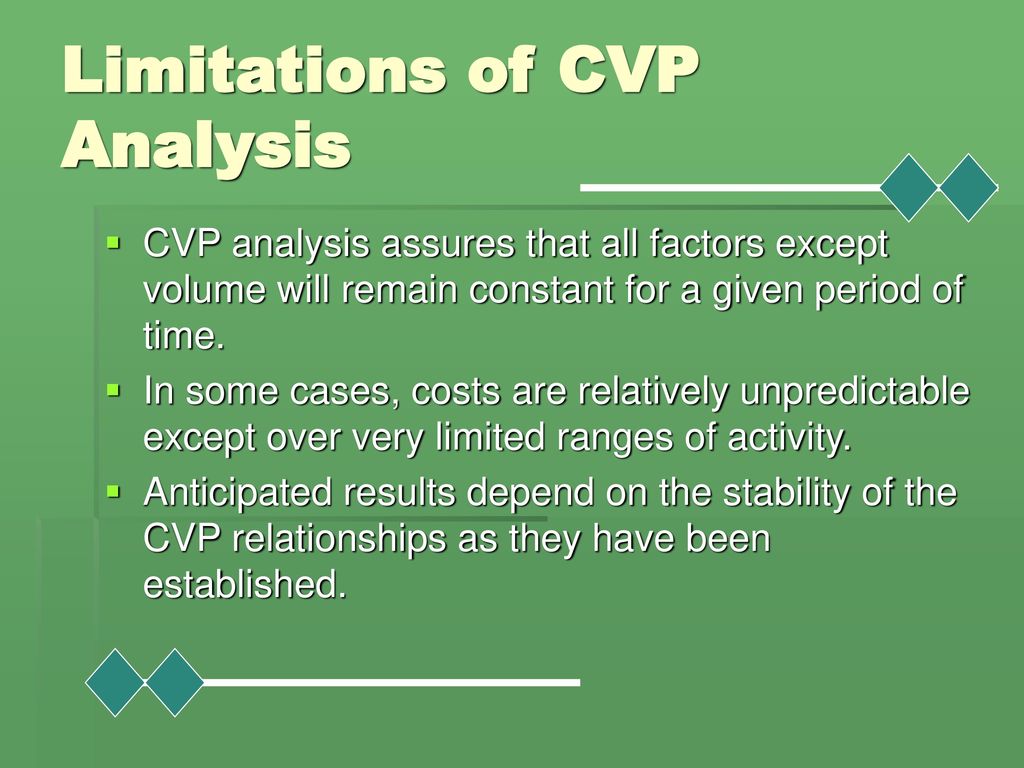LIMITATIONS OF COST VOLUME PROFIT ANALYSIS

Cost‐Volume‐Profit Analysis is the analysis of three variables viz. Cost, Volume and Profit, which explores the relationship existing amongst Costs, Revenue, Activity Levels and the resulting Profit.
ACCORDING TO CHARTERED INSTITUTE OF MANAGEMENT ACCOUNTANTS, LONDON
“CVP the study of the effects on future profit of changes in fixed cost, variable cost, sales price, quantity and mix”.
The break-even point in any business is that point at which the volume of sales or revenues exactly equals total expenses or the point at which there is neither a profit nor loss under varying levels of activity. The break-even point tells the manager what level of output or activity is required before the firm can make a profit; reflects the relationship between costs, volume and profits. In another words breakeven point is the level of sales or production at which the total costs and total revenue of a business are equal.
Break-even sales = (Contribution at break-even point /PV ratio)
OR
Fixed cost / PV ratio
At Break-even point or level, the sales revenues are just equal to the costs incurred. Below Break-even point level the firm will make losses, while above this level it will be making profits. This is so because that while the variable costs vary according to the variations in the volume or level of activity while the fixed costs do not change.
LIMITATIONS OF COST VOLUME PROFIT ANALYSIS
Though break-even analysis has gradually become service tool for modern financial management, there are certain objections raised against the utility of break-even analysis or the limitations of cost volume profit analysis are:
(i) Fixed costs do not always remain constant.
(ii) Variable costs do not always vary proportionately.
(iii) Sales revenue does not always change proportionately.
(iv) The horizontal axis cannot measure the units sold in as much as many unlike type of products are sold by the same enterprise.
(v) Break-even analysis is of doubtful validity when the business is selling many products with different profit margins.
(vi) Break-even analysis is based on the assumption that income is influenced by changes in sales so that changes in inventory would not directly affect income. If marginal costing is used, this assumption would hold good but in other cases, changes in inventory will affect income because the absorption of fixed costs will depend on production rather than sales.
(vii) Condition of growth or expansion in an organisation are not assumed under break-even analysis. In actual life of any business organisation, the operation undergoes a continuous process of growth and expansion.
(viii) Only a limited amount of information can be presented in a single break-even chart. If we have to study the changes of fixed costs, variable costs and selling prices, a number of charts will have to be drawn up.
(ix) Even simple tabulation of the results of costs and sales can serve the purpose which is served by a break-even chart, hence there is no need of presenting the data through a break-even chart.
(x) The chart becomes very complicated and difficult to understand for a layman, if the number of lines or curves depicted on the graph are large.
(xi) The chart does not provide any basis for comparative efficiency between different units or organizations.
